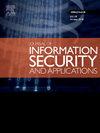基于神经网络的输出预测攻击对对称密钥密码设计的影响
IF 3.8
2区 计算机科学
Q2 COMPUTER SCIENCE, INFORMATION SYSTEMS
Journal of Information Security and Applications
Pub Date : 2025-03-06
DOI:10.1016/j.jisa.2025.104016
引用次数: 0
摘要
证明抵抗常规攻击,例如微分、线性和积分攻击,对于设计安全的对称密钥密码至关重要。自动搜索和基于深度学习的方法的最新进展使这项耗时的任务相对容易,但对专业知识要求和潜在疏忽的担忧仍然存在。为了克服这些问题,Kimura等人提出了基于神经网络的输出预测(NN)攻击,提供了简单性、通用性和减少编码错误。神经网络攻击可以帮助设计安全的对称密钥密码,特别是基于s盒的分组密码。受他们工作的启发,我们首先将神经网络攻击应用于基于and - rotation - xor的分组密码之一Simon,并识别易受神经网络攻击的结构及其检测到的漏洞。接下来,我们仔细看看脆弱的结构。与其他结构相比,最脆弱的结构具有最低的扩散性能。这一事实表明,神经网络攻击可能会检测到这样的属性。然后,我们将重点放在易受攻击的类西蒙密码中核心函数的偏差事件上,并构建由该事件引起的有效线性近似。最后,我们使用这些线性近似来揭示脆弱结构比原始结构更容易受到线性密钥恢复攻击。我们的结论是,我们的分析可以成为使神经网络攻击成为设计安全对称密钥密码的有用工具的坚实一步。本文章由计算机程序翻译,如有差异,请以英文原文为准。
On the effects of neural network-based output prediction attacks on the design of symmetric-key ciphers
Proving resistance to conventional attacks, e.g., differential, linear, and integral attacks, is essential for designing a secure symmetric-key cipher. Recent advances in automatic search and deep learning-based methods have made this time-consuming task relatively easy, yet concerns persist over expertise requirements and potential oversights. To overcome these concerns, Kimura et al. proposed neural network-based output prediction (NN) attacks, offering simplicity, generality, and reduced coding mistakes. NN attacks could be helpful for designing secure symmetric-key ciphers, especially the S-box-based block ciphers. Inspired by their work, we first apply NN attacks to Simon, one of the AND-Rotation-XOR-based block ciphers, and identify structures susceptible to NN attacks and the vulnerabilities detected thereby. Next, we take a closer look at the vulnerable structures. The most vulnerable structure has the lowest diffusion property compared to others. This fact implies that NN attacks may detect such a property. We then focus on a biased event of the core function in vulnerable Simon-like ciphers and build effective linear approximations caused by such an event. Finally, we use these linear approximations to reveal that the vulnerable structures are more susceptible to a linear key recovery attack than the original one. We conclude that our analysis can be a solid step toward making NN attacks a helpful tool for designing a secure symmetric-key cipher.
求助全文
通过发布文献求助,成功后即可免费获取论文全文。
去求助
来源期刊

Journal of Information Security and Applications
Computer Science-Computer Networks and Communications
CiteScore
10.90
自引率
5.40%
发文量
206
审稿时长
56 days
期刊介绍:
Journal of Information Security and Applications (JISA) focuses on the original research and practice-driven applications with relevance to information security and applications. JISA provides a common linkage between a vibrant scientific and research community and industry professionals by offering a clear view on modern problems and challenges in information security, as well as identifying promising scientific and "best-practice" solutions. JISA issues offer a balance between original research work and innovative industrial approaches by internationally renowned information security experts and researchers.
 求助内容:
求助内容: 应助结果提醒方式:
应助结果提醒方式:


